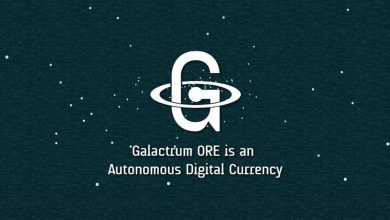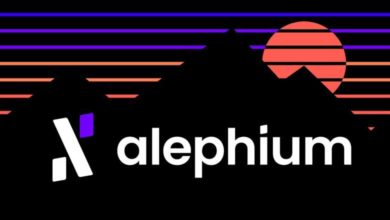How to mine Monero (XMR) – Monero mining in 2022 with CPU & GPU
Monero mining has always been more accessible and is one of the easiest crypto that you can mine. While to mine Bitcoin you require expensive mining hardware; whereas to mine Monero you don’t need any special hardware. The egalitarian principles of Monero blockchain allows anyone with a computer to mine XMR and earn a passive income.
Unlike other mineable coins it doesn’t cost much to start mining Monero. Monero algorithm is CPU friendly and you can simply use your computers CPU (Central Processing Power) to mine it. XMR is one of the coins that you can easily mine by yourself at home using any standard computer and laptop with GPU or CPU. It has a lower barrier to entry and not just PC and MAC but you can even mine Monero on Android mobile.
But, wait! Can you still mine Monero? Is Monero mining profitable in 2022? If you are thinking about mining Monero in 2022 and wondering how to start mining this privacy coin then the following post is for you.
Its a complete Monero mining guide for beginners that covers everything you need to know about Monero (XMR), Random X algorithm and CPU mining. We’ll cover the XMR supply and its emission, OS to mine, XMR mining software, Monero mining pools and the hardware needed for mining XMR.
Monero – XMR
Launched in 2014, Monero is an open source privacy oriented cryptocurrency. It is similar to Bitcoin that can be used to send and receive payments except it has privacy features. Transactions on Monero blockchain are completely anonymous meaning they are untraceable and 100% private. Its a decentralized private cryptocurrency that keeps your finances secure and confidential.
XMR is the native coin of the Monero blockchain. Like Bitcoin; Monero also relies on proof-of-work (PoW) consensus mechanism to achieve distributed consensus. So generating blocks on the network requires computational power and network participants (miners) need to complete block verification’s to mine XMR.
However Mining XMR is quite different than other PoW coins. Monero uses an algorithm that is specifically designed for mining Monero and that does not require any specialized high-performance computers like for Bitcoin. It can be mined by any hobbyist miner with ordinary CPU or GPU.
What Is Monero Mining?
Just like mining any other PoW coin, XMR mining also involves validating transactions on the Monero blockchain. Miners validate transactions and help generate blocks on the network by solving cryptographic puzzles using their computers. For verifying transactions, generating blocks and for securing the network miners earn rewards in the form of XMR coins.
Monero miners combine transactions on the Monero network and start to validate it. Whoever solves the hash (mathematical function) and validate the transactions first earn XMR in return. Miners are rewarded with XMR coins for verifying each block of transactions on the Monero network. This is similar to Bitcoin block rewards. So how many XMR per block?
XMR supply and emission rate
While BTC has a fixed supply of 21 Million coins, XMR doesn’t have such hard cap on its supply. For Monero there is only a soft cap of 18.132 million XMR and there is no max limit on total supply.
After miners mine all the 18.132 million XMR a “tail emission” will start generating 0.6 XMR rewards infinitely. As of May 2022 all the 18.132 million XMR has been mined and now the network issues 0.6 XMR per block. This is set up in such way to keep the miners motivated even after the major portion of the supply has been mined. So verifying transactions on Monero will always remain a rewarding process.
Currently a new block is found every 3 minutes on average and each block contains a reward of 0.62 XMR. This is <1% inflation.
PoW algorithm – RandomX
Most PoW coins like Bitcoin, Litecoin, Dogecoin, Ethereum often requires special purpose hardware such as ASIC (Application Specific Integrated Circuit) to mine them. The problem is not everyone can get their hands on such machines except few big players.
One of the main philosophies of Monero is to maintain egalitarian mining so that everyone can have the possibility to mine and that way they can also improve Monero’s decentralization. The goal is to allow more common users to mine independently rather than allowing only few big mining farms to participate. To achieve this Monero uses an unique hashing algorithm.
Monero was previously using CryptoNight hashing algorithm which resisted ASICs and only allowed GPU and CPU miners. This algorithm was later replaced by RandomX in 2019. RandomX PoW algorithm is ASIC resistant. Not only it keeps ASICs away from the mining scene but it also discourages the development of ASICs. While resisting ASICs it also penalize GPU miners, meaning the network primarily relies on CPU mining rather than GPUs.
XMR can be mined using both CPUs and GPUs, but the former is more efficient. With RandomX CPU mining is currently the best way to mine Monero. You can almost use any CPU for mining Monero but not all will yield profitable results.
So no GPU and no ASICs. How about mobile mining and using MacBook Pro for mining Monero?
Mining XMR on MacBook Pro?
Simply not worth it. If you are thinking of mining Monero when you are not using your Laptop then don’t. Its not worth doing Monero mining on a Mac-book. In fact no Laptop is good enough at mining currently. You’ll make negative money and on top of that you’re still risking damaging your laptop.
These days even desktop computers earn very low income mining Monero so don’t even think about laptop mining. its simply not economical enough. Also note that laptops usually run hot and CPU mining in general gets very hot. So you’ll greatly lower your laptops lifespan trying to generate few cents a day. Even if electricity is Free you shouldn’t mine. Its not even possible to generate revenue to atleast cover the wear and tear of the machine.
In current scenario most desktop processors yield no profits mining Monero. Laptops are worse and Apple laptops are even worse. So simply don’t bother. It’s only going to cost you more than the pay you get out from mining.
Monero mobile mining?
Monero mining on phone? Yes, it’s possible to mine XMR on an Android or tablet running Android. There are many guides on YouTube that shows how to mine XMR (Monero) on Android phone and tablet running Google Android. The guide involves mining Monero on Android via Termux.
Termux is a Linux command line emulator for Android that is available on the Google Play store. This installs Ubuntu on your Android device. To start mining all you have to do is setup Termux and XMRig miner on your mobile. But again don’t expect to make money.
Mobile mining is also not worth it. Mobile phones and tables first of all don’t have much memory or CPU. They have low computing power and they’re very inefficient compared to computers CPU. Also they are not built to sustain the kind of constant heat that is generated from mining. Also you need to keep your phone charged all the time. This will cost you lot more in electric than the XMR you mine. Also this will additionally kill your battery faster and drastically reduces the life of your phone.
If you’re into hobby project and If you are okay killing your phone for less than a penny then you can mine XMR using phone. But if you are serious in acquiring XMR then you might better buy XMR from exchanges like Binance or FTX (Not Finance Advice).
No GPU, no ASIC, no laptop computer and no mobile phones. So what do I need to mine Monero?
Monero mining equipment
Back then Monero mining use to be profitable when done right. It use to be a good option for beginners who don’t want to invest a lots of money to start mining. Anyone with a computer can mine Monero profitably. But Today even with the most efficient hardware’s it is not so profitable. You’ll only earn cents a day. As we said if you want to acquire XMR then better buy it from exchanges. Mining is not so profitable and is not for everyone. But by mining you can get 100% KYC – free XMR.
So what do You Need to Mine Monero? The best hardware for mining Monero is a CPU, however it can be mined with a GPU as well. But with RandomX, GPU mining is no longer effective for Monero mining. If you own GPU then mine Ethereum, mine Ravencoin and other GPU coins. Monero is strictly CPU mining only.
Here are some of the best CPUs for Monero mining . Popular XMR mining CPU includes: Intel Core i9-10900K, Intel Xeon E5-2699 V4, AMD Threadripper 3990X, AMD Ryzen 9 3900X, Ryzen 9 3950X, Ryzen 9 5950X and AMD Ryzen 5 Pro 4650G.
- AMD Ryzen 5 Pro 4650G has an average hash rate of 4170 H/s
- Ryzen7 5800X has a mining power of 9110 H/s
- Ryzen 9 5950X delivers 21.5kH/s
- AMD Ryzen Threadripper 1950X produces anywhere between 1000Hs to 1500Hs
- Intel Core i9-10900K and AMD Ryzen 9 3950X delivers an average hash rate of 8.53 kH/s
All these are excellent for gaming and they also deliver good mining performance on Monero. But don’t buy them specifically for mining thinking that you can get the ROI. No, you won’t.
You should only think about mining if you already have these powerful CPUs. Also your electricity cost should be lower than $0.1 kWh.
Should you mine Monero?
What factors into the profitability of mining Monero and what are the things to consider before you mine? First of all you need to note that that mining comes with certain risk. Monero mining is not worth it and in current scenario you’ll only lose money mining. Do note that the block rewards for mining Monero have also been greatly diminished.
Anyways if you still wish to mine Monero then you need to keep a track of how much you’re earning compared to how much you’ve spent to mine. There are certain mining calculators that can help you with that.
You can use the following tools: https://www.coinwarz.com/mining/monero/calculator, https://whattomine.com/coins/101-xmr-randomx, and Crypto compare mining calculator to calculate your Monero mining rewards.
What factors in most in Monero probability is your
- Mining hardware hashrate / hashpower: The speed at which your device can solve the computational puzzle.
- Power consumption: How much electricity your computer uses when mining.
- Electricity costs (Cost per KWh): How much your electricity costs per unit in your area.
- And lastly the mining pool maintenance fees.
Why join mining pools?
The Monero project encourages users to solo mine XMR to effectively increase the robustness of the Monero network. The official Monero software (GUI and CLI wallet) has the option to mine Monero solo or through P2P pool. Our recommendation is pool mining because it pays you more frequently than solo mining.
Monero mining pool comprises of several individual miners who combine their hash power to increase the chances of finding blocks and getting rewards constantly. Its great for most small scale individual miners as it greatly increases the probability of successful mining. The mined XMR is distributed to the pool, which then is distributed to each miners of the pool proportionally to the hash power they contributed.
By joining Monero mining pool you benefit from the larger combined hash rate of the pool. The reward is divided to miners according to the percentage of the computing power (hash rate) that they contribute. Joining a mining pool means rewards are more stable. However the downside is that most pools charge a fee, which may make mining unprofitable.
Most Monero mining pools charge a fee between 0.6% and 2%. Some popular XMR mining pools are MineXMR, SupportXMR and Nanopool. You can also join a P2P pool.
P2P (Peer-To-Peer) is a decentralized mining pool that allows you to pool mine without needing to trust a centralized pool. P2P pool is a Monero sidechain that is decentralized, permissionless and trustless. Nobody controls the pool and the funds are never in custody. So all pool blocks that are mined are paid out to miners immediately. It uses PPLNS payment scheme, has less than 0.0004 XMR minimum payout (low threshold) and the biggest incentive is the 0% pool fee.
Here we’ll cover Monero mining with both p2p pool and centralized pool.
How to mine Monero (XMR)?
You can mine Monero on all operating systems such as Windows, Linux, Mac and even Android. But here we’ll only cover Windows.
Monero mining is too easy. The general process can be summarized as follows: 1. Create Monero wallet and obtain XMR address. 2. Download the Monero mining software. 3. Join a mining pool. 4. Generate a config file and configure the miner.
Note: We do not endorse any particular software, hardware or mining pool. The content below is provided for informational purposes only and is not financial advise.
Create a Monero Wallet
Firstly you need Monero address to receive XMR mining payouts. You can either download the official Monero GUI wallet which is a full node wallet so it downloads the entire blockchain to your PC. Or you can use MyMonero which is a web wallet. Both are suitable for beginners and advanced users.
Monero GUI wallet has a inbuilt miner and is available for all major operating systems such as Windows, Linux and MacOS. If you are going to use the P2Pool then GUI wallet is recommended. If you’ll be using other centralized pools such as MineXMR, Nano Pool or SupportXMR then you can use the MyMonero wallet.
Learn how to setup and use the MyMonero wallet. Or you can also use one of your favorite cryptocurrency exchange to receive XMR payouts, such as Binance, FTX or Coinbase. All you need to do is go to deposit crypto >> and grab your XMR address.
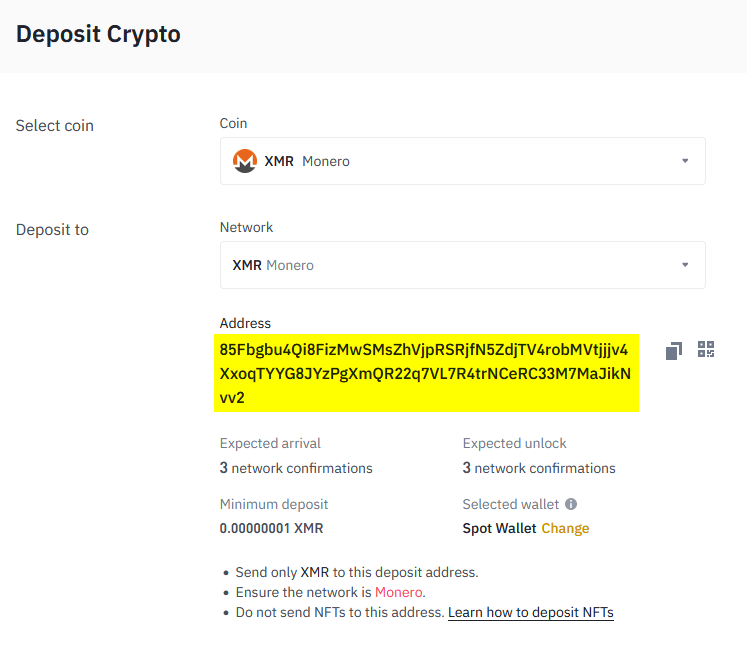
To use the full node Monero GUI wallet go to https://www.getmonero.org/downloads/. There you’ll also find other wallet options such as CLI wallet, mobile light wallets and hardware wallets. Select GUI wallet and download the wallet app for your operating system. Monero GUI Wallet is an open-source graphical user interface that is available for free.
Note: Your wallet downloads may be flagged by your Antivirus or your browser. Just add exclusion and proceed with the download. Also your windows firewall may block some of the wallet features. You just have to allow access.
After downloading unzip the file or run the installer to proceed with the wallet installation. Once done open monero-wallet-gui.exe file to launch the wallet.
Click create new wallet.

On the next screen enter a wallet name, choose wallet location and copy down the mnemonic seed. Mnemonic seed is your wallet backup and it is very important that you write it down and keep it as a secret. Once done click next.

On the next screen choose a strong password for your wallet and click next. You’ll find wallet daemon settings.
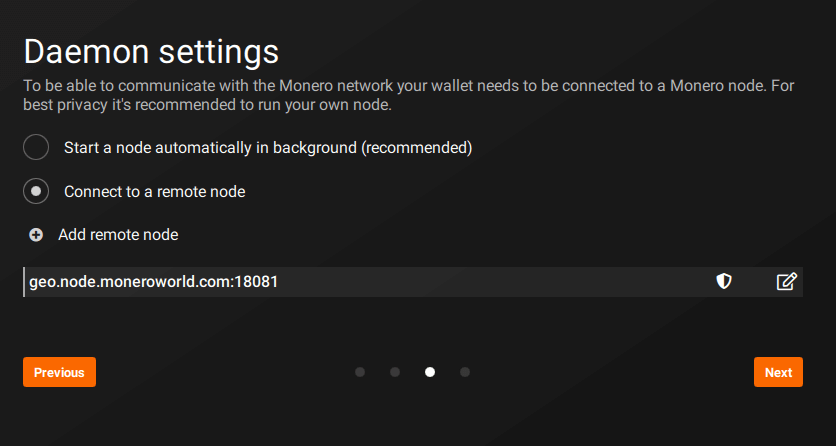
You can either choose to run a full node or connect to a remote node. Full node downloads the entire blockchain to your local computer. And you’ll need atleast 200 GB of disk space. You can use remote node but to use the p2p pool and to mine using your GUI wallet you need to run a full node. Learn how to use remote nodes to run Monero GUI wallet.
Choose connect to a remote node or full node and click next. That’s it! You’re all set up. Verify your wallet details and click create wallet.
Note: To run full node you need atleast 200 GB of disk space. If you do not have space then you can choose to prune the blockchain or you can move the Monero blockchain data directory to another location.
Now enter your wallet password to access your wallet.
Mining Monero using P2Pool
To mine Monero using P2Pool go to advanced >> mining in your GUI wallet. Your daemon must be fully synchronized before you can start mining. If you get daemon failed to start error here is how to fix.
Once the whole Monero blockchain is downloaded and the wallet is fully synchronized go to advanced >> mining. Scroll down and choose the mining mode as P2Pool. Then choose the number of CPU threads that you’d like to use for mining. Select chain as mini which works with most PCs and Laptops.
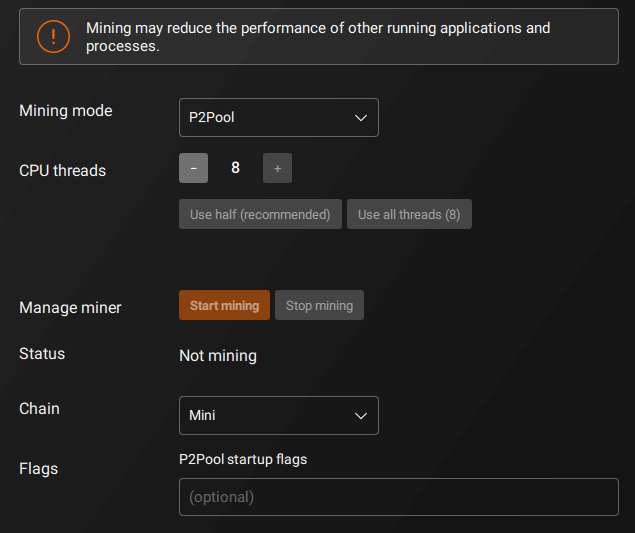
Once everything is setup, click start mining and leave the app running in the background. Your PC or Laptop will now start to mine XMR anonymously in return for securing the Monero network.
Now let’s see how to use other mining pools.
XMR mining software
To connect to a mining pool you need a miner. A Monero miner (RandomX mining software) is an application that helps you to connect your mining hardware to the XMR blockchain or to a mining pool. Monero mining software connects your PC to Monero blockchain and helps you mine Monero.
There are many miners available for mining XMR. Our recommendation is XMRig. It works on all operating systems such as Windows, Linux, Ubuntu, Mac OS and even Android. Here you can check out the list of other RandomX miners. Most miners do charge some developer fees.
Using mining software such as XMRig you can mine XMR with any pool using your GPU or CPU.
Go to https://xmrig.com/download, choose your operating system and download the miner file.
Note: Windows or your browser may flag XMRig as virus. It does this because previously hackers use to install miners unknowingly on users computer to secretly mine XMR for themselves. To prevent such spyware and malware Antivirus programs blocks all kinds of software related to mining and cryptocurrencies. Not to worry. Its a false positive. XMRig is a trusted software and you are downloading it from a reputable source. So just add exclusion and continue with the download.
Once downloaded unzip the file.
Monero mining pools
MineXMR is a high performance Monero mining pool but it is highly centralized. There are many other pools available and you can choose to go with any pool of your choice.
For a complete list of Monero mining pools check out: https://pools.xmr.wiki/ and https://miningpoolstats.stream/monero
It helps you decide which pool to choose. You’ll get a good understanding of all XMR mining pools with information like: pool size (total pool hashrate), number of miners in each pool, pool fees, payout type and minimum pay.
Pick a pool of your choice. It’s time to configure the miner.
Configuring Monero miner
To configure the miner all you have to do is generate a config.json file from xmrig.com and replace with the default config.json file you find in your miner folder.
To do so go to https://xmrig.com/wizard and click new configuration.
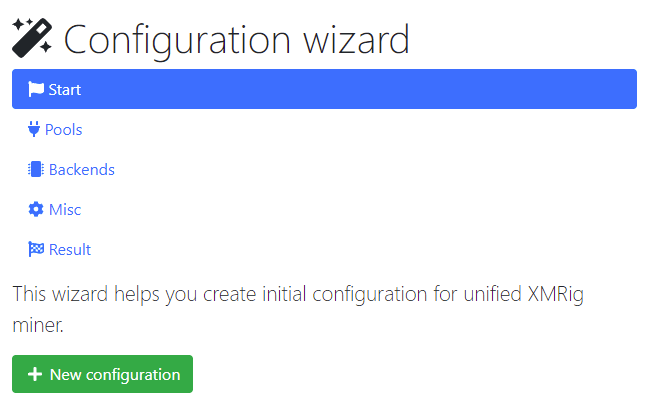
Next drop down add pool (+Add pool) and choose the pool of your choice. You’ll find all the popular Monero mining pools listed there. If you want you can also add a custom pool.
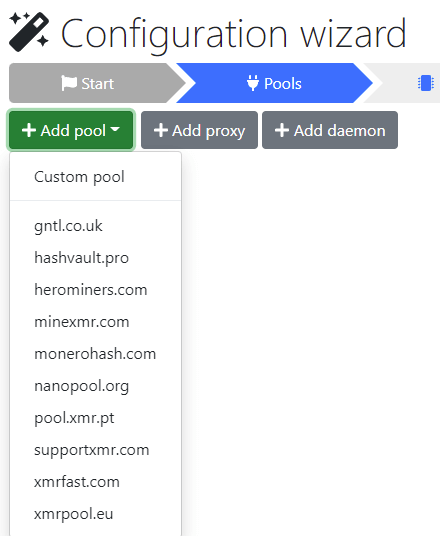
To keep things simpler we’re choosing minexmr.com pool. Once done you’ll be asked to enter your Monero wallet address. Copy your XMR address from your wallet or exchange and input it in wallet address field. Next choose the location that is close to you and click Add pool.

Finalizing the config settings
Navigate to backends tab and choose CPU for mining. XMRig also supports NVIDIA and AMD GPUs. Along with CPU if you also wish to use your GPU then you can do so here. To use AMD GPUs for mining enable OpenCL and to use NVIDIA GPUs for mining enable CUDA.

Here we’ll only be using CPU as GPU mining is not effective.
Next go to misc tab and set the donation amount in percentage. It is miner fee and by default it is set to 5%. You can go as low as 1%. Once after setting this click on the result tab.
XMRig config result
You can either copy the command line or the config file to configure your miner.
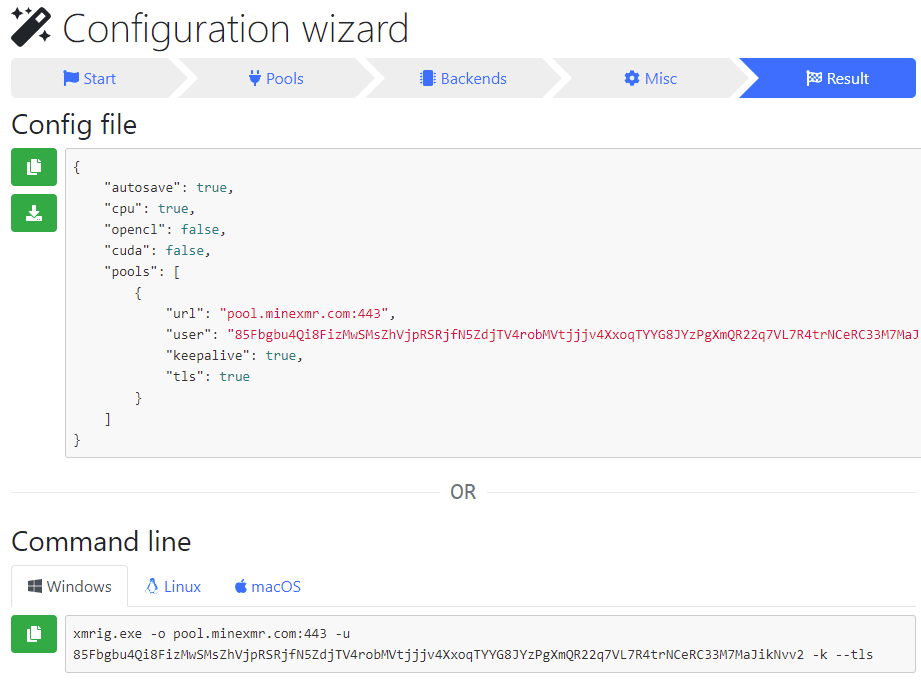
Download the config.json file and replace it with one in your XMRig miner folder.
That’s it! You are now ready to mine Monero. Right click the xmrig.exe file and run the miner as administrator.
Your miner will connect to the pool and begin mining. You’ll see something like this which means you are now mining Monero.

To finetune your miner and for more performance settings check out this XMRig beginners guide.
XMR Mining rewards
By monitoring the miner window you can find out how your hardware performs. It’ll display your hardware’s RandomX hashrate. Once you know your processors hash power use mining calculators to estimate approximately how much your earnings will be for a day and in a month.
You can also check this process on the mining pool. Visit the pool dashboard that is https://minexmr.com/dashboard and enter your Monero mining address. Once you begin finding shares the mining pool will display the information about your miner and its progress. It’ll display your hashrate, your shares and total rewards that you’ve earned so far. It’ll also display the estimated XMR rewards that you’ll earn in a day based on your hashrate.
Once you acquire the minimum balance the pool will deliver your payout. Once it does your earnings will appear in your wallet. You’ll slowly start to see XMR piling up in your wallet.
That’s all. You now know how to mine Monero and you are now a XMR miner. If you need any help or advise then seek the Monero mining community on Reddit: https://www.reddit.com/r/MoneroMining/.


